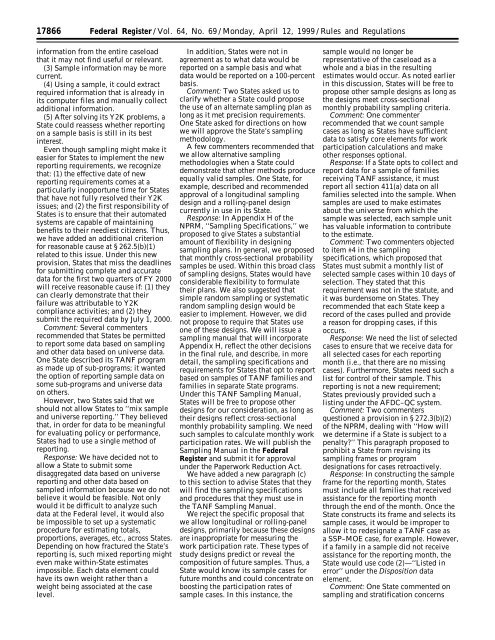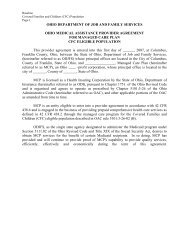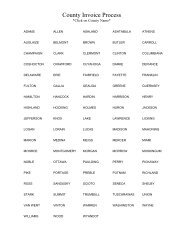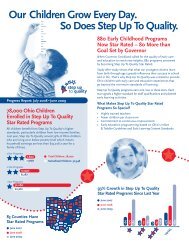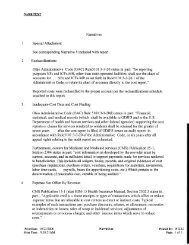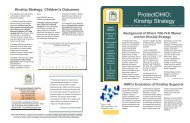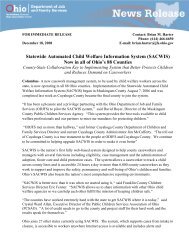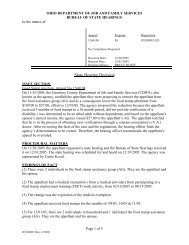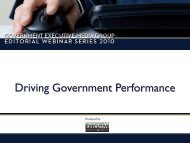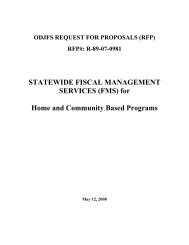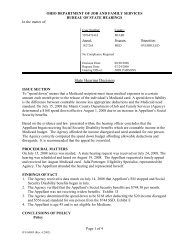Final TANF Rule as published in the Federal Register 4/12/1999
Final TANF Rule as published in the Federal Register 4/12/1999
Final TANF Rule as published in the Federal Register 4/12/1999
You also want an ePaper? Increase the reach of your titles
YUMPU automatically turns print PDFs into web optimized ePapers that Google loves.
17866 <strong>Federal</strong> <strong>Register</strong> / Vol. 64, No. 69 / Monday, April <strong>12</strong>, <strong>1999</strong> / <strong>Rule</strong>s and Regulations<br />
<strong>in</strong>formation from <strong>the</strong> entire c<strong>as</strong>eload<br />
that it may not f<strong>in</strong>d useful or relevant.<br />
(3) Sample <strong>in</strong>formation may be more<br />
current.<br />
(4) Us<strong>in</strong>g a sample, it could extract<br />
required <strong>in</strong>formation that is already <strong>in</strong><br />
its computer files and manually collect<br />
additional <strong>in</strong>formation.<br />
(5) After solv<strong>in</strong>g its Y2K problems, a<br />
State could re<strong>as</strong>sess whe<strong>the</strong>r report<strong>in</strong>g<br />
on a sample b<strong>as</strong>is is still <strong>in</strong> its best<br />
<strong>in</strong>terest.<br />
Even though sampl<strong>in</strong>g might make it<br />
e<strong>as</strong>ier for States to implement <strong>the</strong> new<br />
report<strong>in</strong>g requirements, we recognize<br />
that: (1) <strong>the</strong> effective date of new<br />
report<strong>in</strong>g requirements comes at a<br />
particularly <strong>in</strong>opportune time for States<br />
that have not fully resolved <strong>the</strong>ir Y2K<br />
issues; and (2) <strong>the</strong> first responsibility of<br />
States is to ensure that <strong>the</strong>ir automated<br />
systems are capable of ma<strong>in</strong>ta<strong>in</strong><strong>in</strong>g<br />
benefits to <strong>the</strong>ir neediest citizens. Thus,<br />
we have added an additional criterion<br />
for re<strong>as</strong>onable cause at § 262.5(b)(1)<br />
related to this issue. Under this new<br />
provision, States that miss <strong>the</strong> deadl<strong>in</strong>es<br />
for submitt<strong>in</strong>g complete and accurate<br />
data for <strong>the</strong> first two quarters of FY 2000<br />
will receive re<strong>as</strong>onable cause if: (1) <strong>the</strong>y<br />
can clearly demonstrate that <strong>the</strong>ir<br />
failure w<strong>as</strong> attributable to Y2K<br />
compliance activities; and (2) <strong>the</strong>y<br />
submit <strong>the</strong> required data by July 1, 2000.<br />
Comment: Several commenters<br />
recommended that States be permitted<br />
to report some data b<strong>as</strong>ed on sampl<strong>in</strong>g<br />
and o<strong>the</strong>r data b<strong>as</strong>ed on universe data.<br />
One State described its <strong>TANF</strong> program<br />
<strong>as</strong> made up of sub-programs; it wanted<br />
<strong>the</strong> option of report<strong>in</strong>g sample data on<br />
some sub-programs and universe data<br />
on o<strong>the</strong>rs.<br />
However, two States said that we<br />
should not allow States to ‘‘mix sample<br />
and universe report<strong>in</strong>g.’’ They believed<br />
that, <strong>in</strong> order for data to be mean<strong>in</strong>gful<br />
for evaluat<strong>in</strong>g policy or performance,<br />
States had to use a s<strong>in</strong>gle method of<br />
report<strong>in</strong>g.<br />
Response: We have decided not to<br />
allow a State to submit some<br />
disaggregated data b<strong>as</strong>ed on universe<br />
report<strong>in</strong>g and o<strong>the</strong>r data b<strong>as</strong>ed on<br />
sampled <strong>in</strong>formation because we do not<br />
believe it would be fe<strong>as</strong>ible. Not only<br />
would it be difficult to analyze such<br />
data at <strong>the</strong> <strong>Federal</strong> level, it would also<br />
be impossible to set up a systematic<br />
procedure for estimat<strong>in</strong>g totals,<br />
proportions, averages, etc., across States.<br />
Depend<strong>in</strong>g on how fractured <strong>the</strong> State’s<br />
report<strong>in</strong>g is, such mixed report<strong>in</strong>g might<br />
even make with<strong>in</strong>-State estimates<br />
impossible. Each data element could<br />
have its own weight ra<strong>the</strong>r than a<br />
weight be<strong>in</strong>g <strong>as</strong>sociated at <strong>the</strong> c<strong>as</strong>e<br />
level.<br />
In addition, States were not <strong>in</strong><br />
agreement <strong>as</strong> to what data would be<br />
reported on a sample b<strong>as</strong>is and what<br />
data would be reported on a 100-percent<br />
b<strong>as</strong>is.<br />
Comment: Two States <strong>as</strong>ked us to<br />
clarify whe<strong>the</strong>r a State could propose<br />
<strong>the</strong> use of an alternate sampl<strong>in</strong>g plan <strong>as</strong><br />
long <strong>as</strong> it met precision requirements.<br />
One State <strong>as</strong>ked for directions on how<br />
we will approve <strong>the</strong> State’s sampl<strong>in</strong>g<br />
methodology.<br />
A few commenters recommended that<br />
we allow alternative sampl<strong>in</strong>g<br />
methodologies when a State could<br />
demonstrate that o<strong>the</strong>r methods produce<br />
equally valid samples. One State, for<br />
example, described and recommended<br />
approval of a longitud<strong>in</strong>al sampl<strong>in</strong>g<br />
design and a roll<strong>in</strong>g-panel design<br />
currently <strong>in</strong> use <strong>in</strong> its State.<br />
Response: In Appendix H of <strong>the</strong><br />
NPRM, ‘‘Sampl<strong>in</strong>g Specifications,’’ we<br />
proposed to give States a substantial<br />
amount of flexibility <strong>in</strong> design<strong>in</strong>g<br />
sampl<strong>in</strong>g plans. In general, we proposed<br />
that monthly cross-sectional probability<br />
samples be used. With<strong>in</strong> this broad cl<strong>as</strong>s<br />
of sampl<strong>in</strong>g designs, States would have<br />
considerable flexibility to formulate<br />
<strong>the</strong>ir plans. We also suggested that<br />
simple random sampl<strong>in</strong>g or systematic<br />
random sampl<strong>in</strong>g design would be<br />
e<strong>as</strong>ier to implement. However, we did<br />
not propose to require that States use<br />
one of <strong>the</strong>se designs. We will issue a<br />
sampl<strong>in</strong>g manual that will <strong>in</strong>corporate<br />
Appendix H, reflect <strong>the</strong> o<strong>the</strong>r decisions<br />
<strong>in</strong> <strong>the</strong> f<strong>in</strong>al rule, and describe, <strong>in</strong> more<br />
detail, <strong>the</strong> sampl<strong>in</strong>g specifications and<br />
requirements for States that opt to report<br />
b<strong>as</strong>ed on samples of <strong>TANF</strong> families and<br />
families <strong>in</strong> separate State programs.<br />
Under this <strong>TANF</strong> Sampl<strong>in</strong>g Manual,<br />
States will be free to propose o<strong>the</strong>r<br />
designs for our consideration, <strong>as</strong> long <strong>as</strong><br />
<strong>the</strong>ir designs reflect cross-sectional<br />
monthly probability sampl<strong>in</strong>g. We need<br />
such samples to calculate monthly work<br />
participation rates. We will publish <strong>the</strong><br />
Sampl<strong>in</strong>g Manual <strong>in</strong> <strong>the</strong> <strong>Federal</strong><br />
<strong>Register</strong> and submit it for approval<br />
under <strong>the</strong> Paperwork Reduction Act.<br />
We have added a new paragraph (c)<br />
to this section to advise States that <strong>the</strong>y<br />
will f<strong>in</strong>d <strong>the</strong> sampl<strong>in</strong>g specifications<br />
and procedures that <strong>the</strong>y must use <strong>in</strong><br />
<strong>the</strong> <strong>TANF</strong> Sampl<strong>in</strong>g Manual.<br />
We reject <strong>the</strong> specific proposal that<br />
we allow longitud<strong>in</strong>al or roll<strong>in</strong>g-panel<br />
designs, primarily because <strong>the</strong>se designs<br />
are <strong>in</strong>appropriate for me<strong>as</strong>ur<strong>in</strong>g <strong>the</strong><br />
work participation rate. These types of<br />
study designs predict or reveal <strong>the</strong><br />
composition of future samples. Thus, a<br />
State would know its sample c<strong>as</strong>es for<br />
future months and could concentrate on<br />
boost<strong>in</strong>g <strong>the</strong> participation rates of<br />
sample c<strong>as</strong>es. In this <strong>in</strong>stance, <strong>the</strong><br />
sample would no longer be<br />
representative of <strong>the</strong> c<strong>as</strong>eload <strong>as</strong> a<br />
whole and a bi<strong>as</strong> <strong>in</strong> <strong>the</strong> result<strong>in</strong>g<br />
estimates would occur. As noted earlier<br />
<strong>in</strong> this discussion, States will be free to<br />
propose o<strong>the</strong>r sample designs <strong>as</strong> long <strong>as</strong><br />
<strong>the</strong> designs meet cross-sectional<br />
monthly probability sampl<strong>in</strong>g criteria.<br />
Comment: One commenter<br />
recommended that we count sample<br />
c<strong>as</strong>es <strong>as</strong> long <strong>as</strong> States have sufficient<br />
data to satisfy core elements for work<br />
participation calculations and make<br />
o<strong>the</strong>r responses optional.<br />
Response: If a State opts to collect and<br />
report data for a sample of families<br />
receiv<strong>in</strong>g <strong>TANF</strong> <strong>as</strong>sistance, it must<br />
report all section 411(a) data on all<br />
families selected <strong>in</strong>to <strong>the</strong> sample. When<br />
samples are used to make estimates<br />
about <strong>the</strong> universe from which <strong>the</strong><br />
sample w<strong>as</strong> selected, each sample unit<br />
h<strong>as</strong> valuable <strong>in</strong>formation to contribute<br />
to <strong>the</strong> estimate.<br />
Comment: Two commenters objected<br />
to item #4 <strong>in</strong> <strong>the</strong> sampl<strong>in</strong>g<br />
specifications, which proposed that<br />
States must submit a monthly list of<br />
selected sample c<strong>as</strong>es with<strong>in</strong> 10 days of<br />
selection. They stated that this<br />
requirement w<strong>as</strong> not <strong>in</strong> <strong>the</strong> statute, and<br />
it w<strong>as</strong> burdensome on States. They<br />
recommended that each State keep a<br />
record of <strong>the</strong> c<strong>as</strong>es pulled and provide<br />
a re<strong>as</strong>on for dropp<strong>in</strong>g c<strong>as</strong>es, if this<br />
occurs.<br />
Response: We need <strong>the</strong> list of selected<br />
c<strong>as</strong>es to ensure that we receive data for<br />
all selected c<strong>as</strong>es for each report<strong>in</strong>g<br />
month (i.e., that <strong>the</strong>re are no miss<strong>in</strong>g<br />
c<strong>as</strong>es). Fur<strong>the</strong>rmore, States need such a<br />
list for control of <strong>the</strong>ir sample. This<br />
report<strong>in</strong>g is not a new requirement;<br />
States previously provided such a<br />
list<strong>in</strong>g under <strong>the</strong> AFDC–QC system.<br />
Comment: Two commenters<br />
questioned a provision <strong>in</strong> § 272.3(b)(2)<br />
of <strong>the</strong> NPRM, deal<strong>in</strong>g with ‘‘How will<br />
we determ<strong>in</strong>e if a State is subject to a<br />
penalty?’’ This paragraph proposed to<br />
prohibit a State from revis<strong>in</strong>g its<br />
sampl<strong>in</strong>g frames or program<br />
designations for c<strong>as</strong>es retroactively.<br />
Response: In construct<strong>in</strong>g <strong>the</strong> sample<br />
frame for <strong>the</strong> report<strong>in</strong>g month, States<br />
must <strong>in</strong>clude all families that received<br />
<strong>as</strong>sistance for <strong>the</strong> report<strong>in</strong>g month<br />
through <strong>the</strong> end of <strong>the</strong> month. Once <strong>the</strong><br />
State constructs its frame and selects its<br />
sample c<strong>as</strong>es, it would be improper to<br />
allow it to redesignate a <strong>TANF</strong> c<strong>as</strong>e <strong>as</strong><br />
a SSP–MOE c<strong>as</strong>e, for example. However,<br />
if a family <strong>in</strong> a sample did not receive<br />
<strong>as</strong>sistance for <strong>the</strong> report<strong>in</strong>g month, <strong>the</strong><br />
State would use code (2)—‘‘Listed <strong>in</strong><br />
error’’ under <strong>the</strong> Disposition data<br />
element.<br />
Comment: One State commented on<br />
sampl<strong>in</strong>g and stratification concerns


